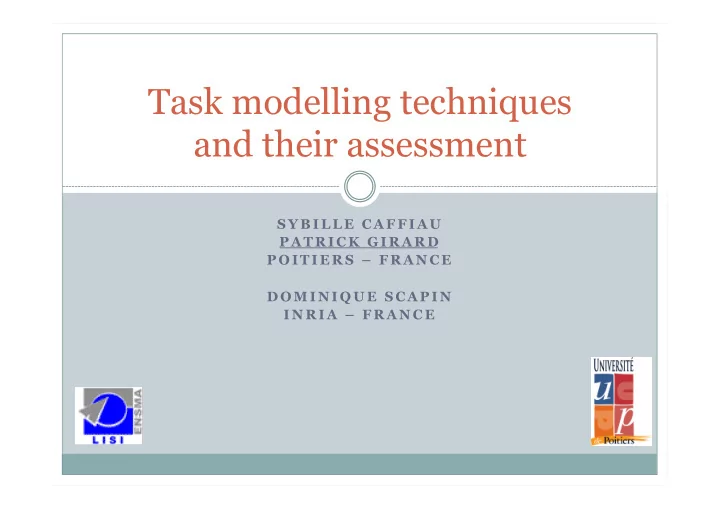

Task modelling techniques and their assessment S Y B I L L E C A F F I A U P A T R I C K G I R A R D P O I T I E R S – F R A N C E D O M I N I Q U E S C A P I N I N R I A – F R A N C E
Our contribution to MBUI (1) The K-MAD model and the K-MADe tool Result of years of work on the subject (MAD, MAD*, …) A kernel, which has been designed to allow « plugging » extensions for specific needs A hierarchical task model, which includes domain objects and computable conditions (pre-conditions, post-conditions) An enhanced simulation tool, which allows syntaxic and semantic versifications, and manages conditions.
Our contribution to MBUI (2) The Dialog Hierarchy model and model-based tools Result of years of work on the subject (Hierarchical Interactors, Diagets, MB Tools, …) A dialogue model (Abstract User Interface), which has been designed to allow a specific description of dialogue A library, which allows easy implementation of such dialogues
Our contribution to MBUI (3) - Applicability Assumption: One of the most interesting advantage of task-based model based approach Automating semantic validation of applications Case studies A proposal for model-based co-design of Task models and Abstract User Interfaces Based of large assessment of models By way of model meta-modelling Based on rules between meta-models
1- Case studies Several case studies, which allow exploring the limitations of model usage Complete case studies Mastermind Volley-Ball marking sheet Biological analysis laboratory Open case studies Emailer Smartphone …
2- Proposal Model-based co-design of Task models and Abstract User Interfaces
1. Development cycles in HCI Prototyping Participatory Design Evaluation Iterative cycles
2. Model-Driven Approaches Promote usage of models in software design Main usage of generation Model 1 Model 2 Model n Code How does it fit with iterative cycles ?
Our proposal Instead of building "one way" tranformations… Model 1 Model 2 Elaborating "bidirectional" transformations Model 1 Model 2
Our method: first step Meta - Meta - Rules Model Model Part of AUI Task Dialogue Model Model
Our method: second step Rules Part of AUI Task Dialogue Exploiting Model Model the rules
Summary Allows generation Allows verifications between models Allows iterative design Experienced with two specific models K-MAD for task models Hierachical Interactor for dialogue models Seems to be usable with other models All hierarchical task models All state-based dialogue models To be defined on standards
Future works and open questions Future works Implementing rules in tools (Eclipse ?) Study how it can be used with other formalisms Open questions Link with the Domain Model ? Complete definition of the Abstract User Interface ? Link with the Concrete User Interface ?
Recommend
More recommend